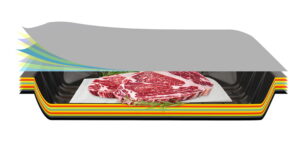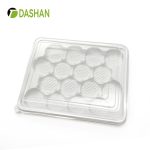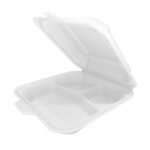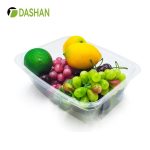Why Meat Plastic Trays Matter in Modern Food Packaging
Fresh meat is highly perishable, and proper packaging directly affects its shelf life, appearance, and food safety. A high-quality meat plastic tray provides:
-
Leak-proof protection to prevent contamination and maintain hygiene.
-
Strong structure to support heavy cuts of beef, pork, or poultry.
-
Clear visibility to enhance product appeal and boost sales.
When you invest in the right tray, you protect your product, brand reputation, and your customers’ health.
Common Materials for Meat Plastic Trays
Selecting the right material is crucial for performance and sustainability. The most popular options include:
| Material | Key Features | Applications |
|---|---|---|
| PET / RPET | Excellent clarity, recyclable, strong impact resistance | Premium retail display |
| PP (Polypropylene) | Lightweight, heat-resistant, cost-effective | Fresh & frozen meat |
| CPET | Oven & microwave safe, high heat resistance | Ready-to-cook meals |
💡 Tip: If you want an eco-friendly solution, RPET (recycled PET) or PLA (biodegradable) trays reduce environmental impact without compromising performance.
Key Features to Look for in a Meat Plastic Tray
When evaluating suppliers, focus on these critical factors:
-
Food-Grade Certification – Ensure the tray meets FDA, LFGB, or EU standards.
-
Anti-Fog Lids or Films – Maintain product visibility in refrigerated conditions.
-
Custom Fit & Sizes – Different cuts of meat require trays of varying depths and capacities.
-
Leak-Proof Sealing – Look for compatible sealing films to keep liquids contained.
-
Stackability – Efficient stacking reduces storage and shipping costs.
Advantages of Using High-Quality Meat Plastic Trays
-
✅ Extended Shelf Life: Reduces oxidation and bacterial growth.
-
✅ Enhanced Brand Image: Transparent trays highlight product freshness.
-
✅ Cost Efficiency: Lightweight design lowers shipping and handling costs.
-
✅ Versatile Applications: Suitable for beef, poultry, seafood, and ready-to-cook meals.
Customization Options for Meat Plastic Trays
To stand out in a competitive market, consider these customization services:
-
Logo embossing or printing for brand recognition.
-
Color options (clear, black, or custom Pantone shades).
-
Special shapes or compartments for premium meat cuts.
-
Material upgrades for compostable or recyclable trays.
A professional supplier can guide you through material selection, mold development, and production to ensure your trays meet both functional and branding requirements.
Sustainability Trends in Meat Packaging
As consumers demand eco-friendly solutions, sustainable meat plastic trays are becoming the new standard. Key trends include:
-
RPET Content: Incorporating post-consumer recycled PET.
-
Biodegradable PLA: Plant-based and compostable under industrial conditions.
-
Lightweight Design: Reducing plastic usage without sacrificing strength.
Choosing an environmentally responsible tray not only supports your CSR goals but also appeals to eco-conscious customers.
How to Source Reliable Meat Plastic Trays
When searching for a supplier, prioritize manufacturers that offer:
-
International Certifications (BRC, ISO, FDA, LFGB).
-
In-house Design & Mold Services for custom solutions.
-
High-Capacity Production to handle bulk orders.
-
Consistent Quality Control for every shipment.
Dashan, for example, operates advanced extrusion and blistering lines to deliver food-grade trays with quick turnaround times.
Frequently Asked Questions (FAQ)
1. What are meat plastic trays made of?
Most meat plastic trays are made from PET, RPET, PP, PS, or CPET. PET and RPET provide excellent clarity and recyclability, while PP offers lightweight durability and heat resistance. Your choice depends on whether you prioritize sustainability, cost, or temperature resistance.
2. Are meat plastic trays safe for food contact?
Yes. High-quality meat plastic trays are manufactured with food-grade materials that comply with FDA, LFGB, and EU food safety standards. Always buy from certified suppliers to ensure there are no harmful chemicals or contaminants.
3. Can meat plastic trays be recycled?
Many trays—especially those made of PET or RPET—are widely recyclable. PP trays can also be recycled in certain regions. Check local recycling guidelines and encourage customers to dispose of trays in designated recycling bins.
4. How do meat plastic trays keep meat fresh?
These trays create a leak-proof, hygienic barrier that protects meat from external contamination and moisture loss. When combined with vacuum-sealing or anti-fog film, they help extend shelf life and maintain product color and texture.
5. Can I customize the size or design of meat plastic trays?
Absolutely. Professional manufacturers offer custom mold design, logo embossing, and various colors or compartments. Customization ensures the tray perfectly fits your product, improves brand visibility, and enhances the shopping experience.
Conclusion
The right meat plastic tray can make a significant difference in freshness, presentation, and overall product value. Whether you’re a supermarket, butcher shop, or food processing company, investing in high-quality trays ensures customer satisfaction and regulatory compliance. Choose a supplier that offers certified materials, flexible customization, and eco-friendly options to stay ahead in today’s competitive food packaging industry.





